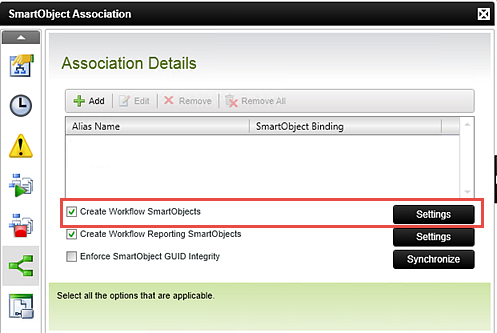Workflow Service
The Workflow Service Service Type exposes runtime operations for adding comments and attachments to a workflow.
Service Authentication
The following Authentication Modes may be used with the Service Type:
- Impersonate
- ServiceAccount
- Single Single-on
- Static
Service Keys (Service Instance Configuration Settings)

| Key | Can be modified | Data Type | Sample Value | Notes |
|---|---|---|---|---|
| Workflow Server | Yes | Text | Integrated=True;IsPrimaryLogin=True; Authenticate=True;EncryptedPassword=False; Host=localhost;Port=5252 | Connection string to the K2 server |
| Workflow LogDB Connection String | Yes | Text | Data Source=[SqlServerName];Initial Catalog=K2;integrated security=sspi; Pooling=True | SQL connection string to the K2 database |
| Workflow DB Connection String | Yes | Text | Data Source=[SqlServerName];Initial Catalog=K2;integrated security=sspi; Pooling=True | SQL connection string to the K2 database |
Service Objects
During installation of K2, the Workflow Service Instance creates Service Objects in the Workflow Service category, which are used by K2 to manage comments and attachments to workflow instances. The screenshot below shows the available methods of these Service Objects.

In addition, if workflows are deployed with the Create Workflow SmartObjects option selected, the service will create Service Objects for the selected items in the configuration of the Create Workflow SmartObjects screen, as specified by the workflow designer.


SmartObjects
K2 automatically generates SmartObjects for these Service Objects. SmartObjects are automatically created when selecting the Generate SmartObjects for this Service Instance check box when creating a new Service Instance. Designers may use the available Service Objects in this service to create advanced SmartObjects using the available K2 SmartObject design tools. It is recommended to use the K2 Design tools to create SmartObjects rather than generating SmartObjects, since this allows better control over the naming, behavior and design of the SmartObject and its methods and properties.
Considerations
- The Create Workflow SmartObjects property must be set to True on the process properties to create workflow-specific SmartObjects when the process is deployed.
- You may want to limit the number of processes that generate Workflow SmartObjects since it can increase the amount of time taken to deploy the workflow definition.